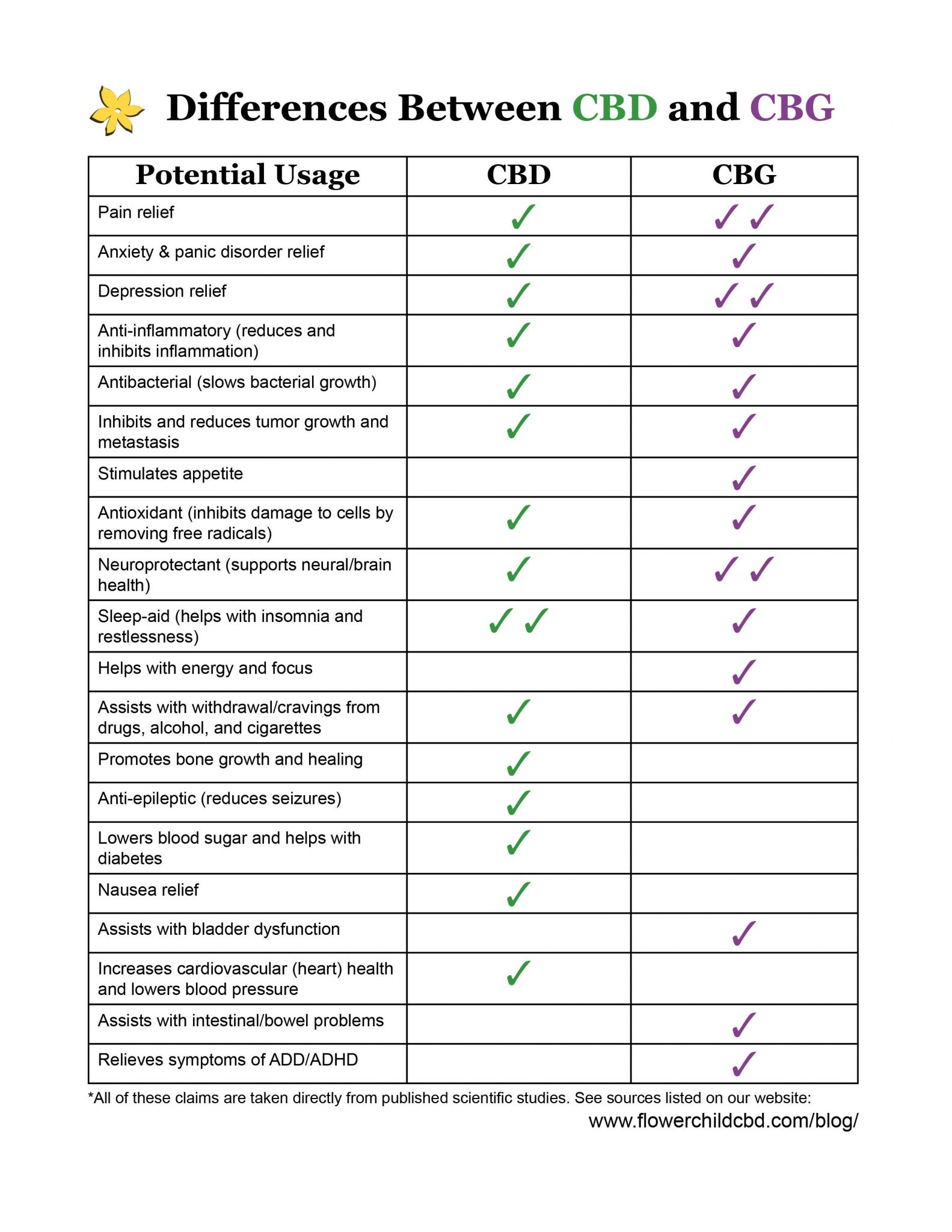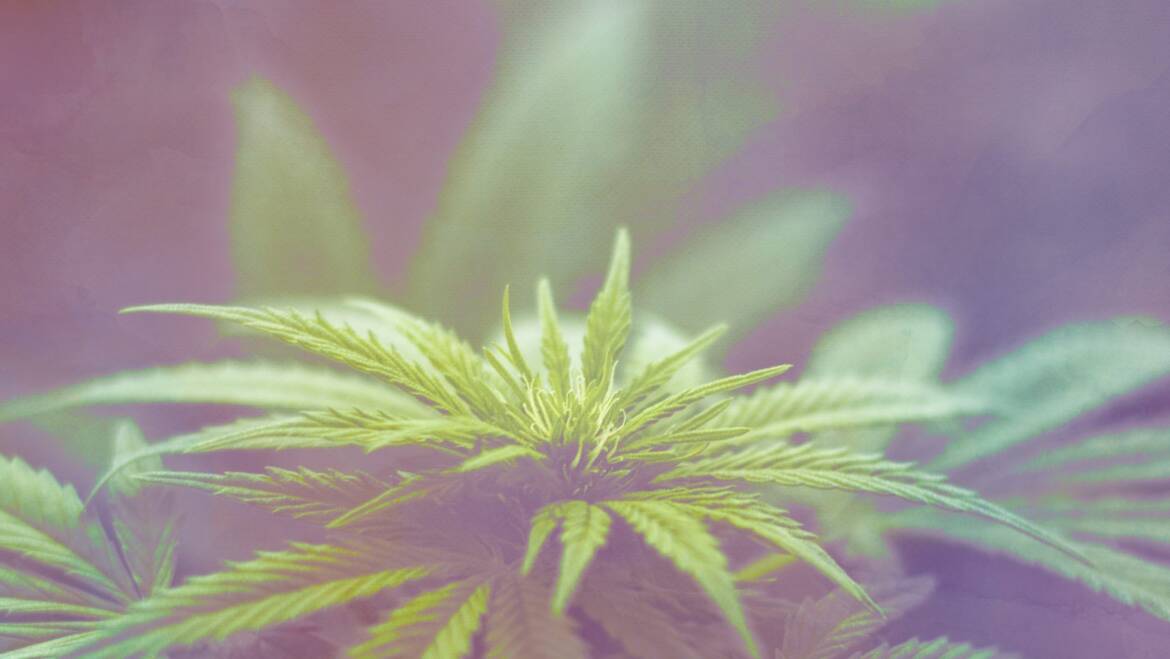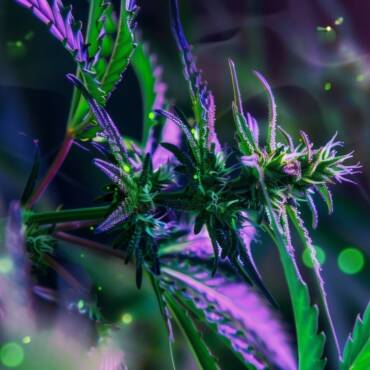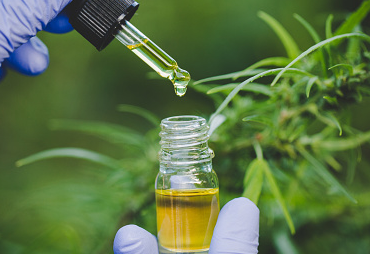 Differences between CBD and CBG
Differences between CBD and CBG
Please refer to the chart above for an easy way to understand some of the differences between CBD and CBG. Both CBD and CBG have similar uses and effects, but CBD works better for some conditions and CBG works better for others. You can learn more about the differences between CBD and CBG by checking out some of our articles linked below. Keep in mind that the chart above is created using only scientific studies, and that published research about CBD and CBG is still limited. We recommend also reading the customer testimonials on our product pages for reports from people who have tried the products themselves.
If you’d like to purchase premium quality CBD and CBG products, head on over to our shop section!
More Articles about CBG and the differences of CBG vs. CBD
- CBG Benefits: What Terpenes are in it and What Does it Do?
- CBD Hemp Products vs. CBG Hemp Products
- What is CBG?
- Where to Buy CBG: Can I Buy CBG Online?
- Cannabis and the Endocannabinoid System
Sources for the Chart:
Valdeolivas, S., Navarrete, C., Cantarero, I., Bellido, M. L., Muñoz, E., & Sagredo, O. (2015). Neuroprotective Properties of Cannabigerol in Huntington’s Disease: Studies in R6/2 Mice and 3-Nitropropionate-lesioned Mice. Neurotherapeutics, 12(1), 185–199. http://doi.org/10.1007/s13311-014-0304-z
(https://www.ncbi.nlm.nih.gov/pmc/articles/PMC4322067/)
Ladin, D. A., Soliman, E., Griffin, L., & Van Dross, R. (2016). Preclinical and Clinical Assessment of Cannabinoids as Anti-Cancer Agents. Frontiers in Pharmacology, 7, 361. http://doi.org/10.3389/fphar.2016.00361
(https://www.ncbi.nlm.nih.gov/pmc/articles/PMC5054289/)
Pagano E, Montanaro V, Di Girolamo A, Pistone A, Altieri V, Zjawiony JK, Izzo AA, Capasso R. (2015). Effect of Non-psychotropic Plant-derived Cannabinoids on Bladder Contractility: Focus on Cannabigerol. Nat Prod Commun. 2015 Jun;10(6):1009-12. (https://www.ncbi.nlm.nih.gov/pubmed/26197538)
Russo, E. B. (2008). Cannabinoids in the management of difficult to treat pain. Therapeutics and Clinical Risk Management, 4(1), 245–259. (https://www.ncbi.nlm.nih.gov/pmc/articles/PMC2503660/)
Giovanni Appendino, Simon Gibbons, Anna Giana, Alberto Pagani, Gianpaolo Grassi, Michael Stavri, Eileen Smith, and M. Mukhlesur Rahman. Antibacterial Cannabinoids from Cannabis sativa: A Structure−Activity Study.
Journal of Natural Products 2008 71 (8), 1427-1430
DOI: 10.1021/np8002673 (https://pubs.acs.org/doi/full/10.1021/np8002673)
Cascio, M., Gauson, L., Stevenson, L., Ross, R., & Pertwee, R. (2010). Evidence that the plant cannabinoid cannabigerol is a highly potent α2-adrenoceptor agonist and moderately potent 5HT1A receptor antagonist. British Journal of Pharmacology, 159(1), 129–141. http://doi.org/10.1111/j.1476-5381.2009.00515.x (https://www.ncbi.nlm.nih.gov/pmc/articles/PMC2823359/)
Nagarkatti, P., Pandey, R., Rieder, S. A., Hegde, V. L., & Nagarkatti, M. (2009). Cannabinoids as novel anti-inflammatory drugs. Future Medicinal Chemistry, 1(7), 1333–1349. http://doi.org/10.4155/fmc.09.93
(https://www.ncbi.nlm.nih.gov/pmc/articles/PMC2828614/)
Parker, L. A., Rock, E. M., & Limebeer, C. L. (2011). Regulation of nausea and vomiting by cannabinoids. British Journal of Pharmacology, 163(7), 1411–1422. http://doi.org/10.1111/j.1476-5381.2010.01176.x
(https://www.ncbi.nlm.nih.gov/pmc/articles/PMC3165951/)
Cunha J, M, Carlini E, A, Pereira A, E, Ramos O, L, Pimentel C, Gagliardi R, Sanvito W, L, Lander N, Mechoulam R, Chronic Administration of Cannabidiol to Healthy Volunteers and Epileptic Patients. Pharmacology 1980;21:175-185
(https://www.karger.com/Article/Abstract/137430#)
Natalya M Kogan, Eitan Melamed, Elad Wasserman, Bitya Raphael, Aviva Breur. Cannabidiol, a Major Non‐Psychotropic Cannabis Constituent Enhances Fracture Healing and Stimulates Lysyl Hydroxylase Activity in Osteoblasts. American Society for Bone and Mineral Research, 2015. https://doi.org/10.1002/jbmr.2513
(https://onlinelibrary.wiley.com/doi/full/10.1002/jbmr.2513)
Francisco J Alvarez, Hector Laufuente, M Carmen Rey-Santano, Victoria E Mielgo, Elena Gastiasoro, Miguel Rueda, Roger G Pertwee, Ana I Castillo. Neuroprotective Effects of the Nonpsychoactive Cannabinoid Cannabidiol in Hypoxic-Ischemic Newborn Piglets. Pediatric Research, 64, 653–658 (2008).
(https://www.nature.com/articles/pr2008260#author-information)
Cascio, M., Gauson, L., Stevenson, L., Ross, R., & Pertwee, R. (2010). Evidence that the plant cannabinoid cannabigerol is a highly potent α2-adrenoceptor agonist and moderately potent 5HT1A receptor antagonist. British Journal of Pharmacology, 159(1), 129–141. http://doi.org/10.1111/j.1476-5381.2009.00515.x
(https://www.ncbi.nlm.nih.gov/pmc/articles/PMC2823359/_
Giovannitti, J. A., Thoms, S. M., & Crawford, J. J. (2015). Alpha-2 Adrenergic Receptor Agonists: A Review of Current Clinical Applications. Anesthesia Progress, 62(1), 31–38. http://doi.org/10.2344/0003-3006-62.1.31
(https://www.ncbi.nlm.nih.gov/pmc/articles/PMC4389556/)
Prud’homme, Mélissa et al. “Cannabidiol as an Intervention for Addictive Behaviors: A Systematic Review of the Evidence.” Substance abuse : research and treatment vol. 9 33-8. 21 May. 2015, doi:10.4137/SART.S25081 (https://www.ncbi.nlm.nih.gov/pmc/articles/PMC4444130/)






